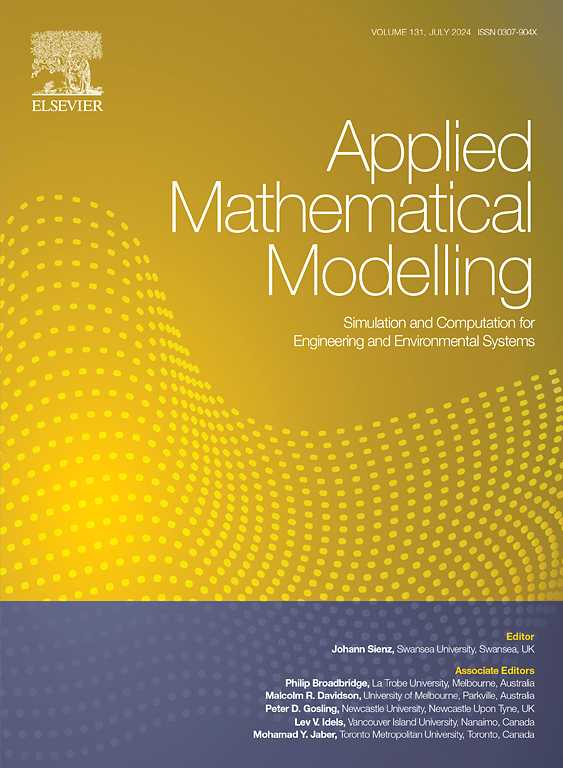Mathematical modelling for large-aperture mirror systems: enabling optical-mechanical performance analysis and support structure optimization
IF 4.4
2区 工程技术
Q1 ENGINEERING, MULTIDISCIPLINARY
引用次数: 0
Abstract
Large-aperture mirror systems (LAMS) are widely used in fields such as electro-optical countermeasures, spaceborne remote sensing, and laser communication. Accurate modeling and analysis of LAMS are crucial for its design and optimization. To transition from one-off simulation models to a generalized theoretical mathematical model, this paper presents a theoretical modeling method that combines the Reciprocal Theorem of Work and the Perturbation Method. First, based on the Kirchhoff plate theory, a variable-coefficient deflection governing equations for LAMS is derived. Then, using the principles of the Perturbation Method, an analytical solution for the governing equations within the framework of the Reciprocal Theorem of Work is obtained. Additionally, the proposed governing equations are validated for convergence, and it is found that the solution converges when m ≥ 3. By comparing with FEM results, the accuracy of the proposed model is confirmed, with the root mean square error (RMSE) below 9.918 × 10-4 and R2 exceeding 0.875. Furthermore, the influence of higher-order perturbation terms and computational efficiency are analyzed. The results show that the first-order perturbation solution satisfies the accuracy requirements, and the proposed method offers significant computational efficiency advantages over FEM. Finally, for a specific LAMS model, the proposed governing equations are applied to optimize its support scheme. The results indicate that, for 9 support points, the optimal radius of the inner supports is 0.267a, while the outer supports have an optimal radius of 0.775a. For 18 support points, the optimal radius of the inner supports is 0.343a, with the outer supports having an optimal radius of 0.811a. Overall, the proposed method establishes a theoretical foundation for designing and optimizing the support structures of LAMS, significantly facilitating engineers in optimizing its optomechanical performance.
大口径反射镜系统的数学建模:实现光学机械性能分析和支撑结构优化
大口径反射镜系统在光电对抗、星载遥感、激光通信等领域有着广泛的应用。准确的建模和分析对其设计和优化至关重要。为了从一次性的仿真模型过渡到广义的理论数学模型,本文提出了一种结合功的互反定理和摄动法的理论建模方法。首先,基于Kirchhoff板理论,推导了LAMS变系数挠度控制方程。然后,利用摄动法的原理,在功的互反定理的框架内得到了控制方程的解析解。此外,对所提出的控制方程进行了收敛性验证,发现当m≥3时,解是收敛的。通过与有限元结果的比较,验证了所建模型的准确性,均方根误差(RMSE)小于9.918 × 10-4, R2大于0.875。进一步分析了高阶扰动项和计算效率的影响。结果表明,一阶摄动解满足精度要求,与有限元方法相比,该方法具有显著的计算效率优势。最后,针对一个具体的LAMS模型,应用所提出的控制方程对其支撑方案进行优化。结果表明:对于9个支撑点,内支架的最优半径为0.267a,外支架的最优半径为0.775a。对于18个支撑点,内支撑点的最佳半径为0.334 a,外支撑点的最佳半径为0.811a。总体而言,所提出的方法为LAMS支撑结构的设计和优化奠定了理论基础,为工程师优化其光力学性能提供了显著的便利。
本文章由计算机程序翻译,如有差异,请以英文原文为准。
求助全文
约1分钟内获得全文
求助全文
来源期刊

Applied Mathematical Modelling
数学-工程:综合
CiteScore
9.80
自引率
8.00%
发文量
508
审稿时长
43 days
期刊介绍:
Applied Mathematical Modelling focuses on research related to the mathematical modelling of engineering and environmental processes, manufacturing, and industrial systems. A significant emerging area of research activity involves multiphysics processes, and contributions in this area are particularly encouraged.
This influential publication covers a wide spectrum of subjects including heat transfer, fluid mechanics, CFD, and transport phenomena; solid mechanics and mechanics of metals; electromagnets and MHD; reliability modelling and system optimization; finite volume, finite element, and boundary element procedures; modelling of inventory, industrial, manufacturing and logistics systems for viable decision making; civil engineering systems and structures; mineral and energy resources; relevant software engineering issues associated with CAD and CAE; and materials and metallurgical engineering.
Applied Mathematical Modelling is primarily interested in papers developing increased insights into real-world problems through novel mathematical modelling, novel applications or a combination of these. Papers employing existing numerical techniques must demonstrate sufficient novelty in the solution of practical problems. Papers on fuzzy logic in decision-making or purely financial mathematics are normally not considered. Research on fractional differential equations, bifurcation, and numerical methods needs to include practical examples. Population dynamics must solve realistic scenarios. Papers in the area of logistics and business modelling should demonstrate meaningful managerial insight. Submissions with no real-world application will not be considered.
 求助内容:
求助内容: 应助结果提醒方式:
应助结果提醒方式:


